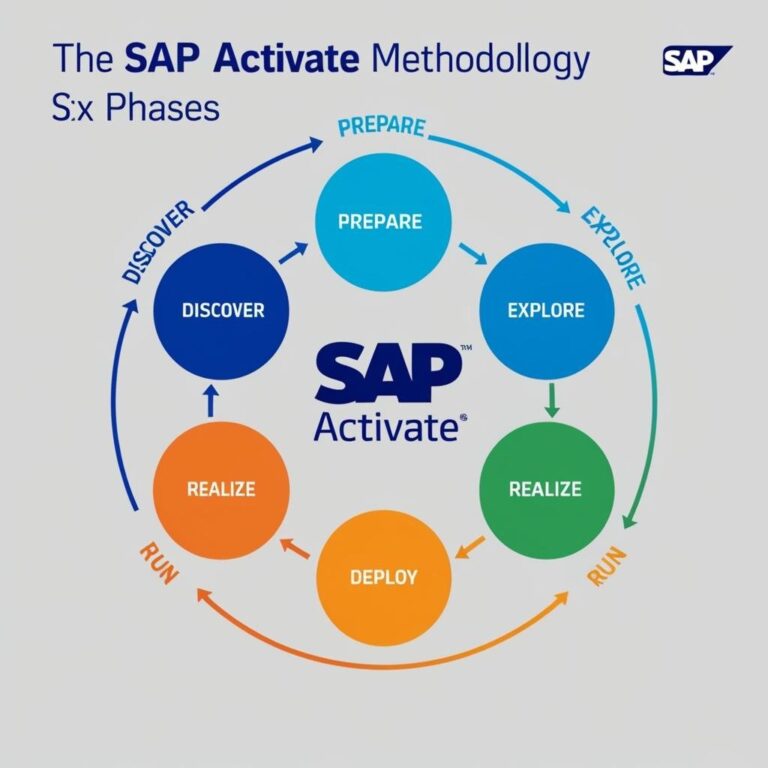MM Organizational Structure in SAP – A Complete Beginner’s Guide (2025)
If you’re starting your journey in SAP MM (Materials Management), one of the first topics you’ll learn is the organizational structure. It forms the backbone of all processes in SAP because every business transaction — from purchasing materials to managing inventory — depends on this structure.
In this blog, we’ll explain in simple, easy-to-understand language what the MM Organizational Structure in SAP is, why it is important, and how it is configured. We’ll also explore related topics like SAP MM Organizational Structure PDF, examples, and SAP Enterprise Structure Configuration.
This detailed guide is brought to you by GTR Academy, a trusted name in SAP training, helping students and professionals learn practical SAP skills with expert guidance and real-time project examples.
Connect With Us: WhatsApp

What is MM Organizational Structure in SAP?
The MM Organizational Structure in SAP defines how a company’s procurement and inventory management activities are organized. It represents the hierarchy or framework that shows how different business units are connected and how they work together in the materials management process.
In simple words, the MM organizational structure tells SAP:
“How is my company divided for purchasing and material management?”
This structure includes various organizational units such as Client, Company Code, Plant, Storage Location, and Purchasing Organization. Each unit plays a unique role in how materials are bought, stored, and managed.
Key Components of MM Organizational Structure in SAP
Let’s understand the main elements that form the organizational structure in SAP MM, step by step.
1. Client
The Client is the highest level in the SAP system.
It represents the entire organization or group of companies.
All data in SAP, such as materials, vendors, and configurations, are stored at the client level and can be shared across all company codes under it.
2. Company Code
A Company Code is a small, independent legal unit within the organization.
It represents a separate accounting entity where all financial transactions like purchasing, payments, and reporting are recorded.
Each company code has its own balance sheet and profit & loss statement.
3. Plant
The Plant is one of the most important organizational units in SAP MM.
It refers to a place where materials are manufactured, kept, or supplied.
A plant can be a manufacturing site, a warehouse, or even a distribution center.
In procurement, all goods receipts, inventory updates, and material storage activities happen at the plant level.
4. Storage Location
Within each plant, there are multiple Storage Locations.
These are physical or logical places where materials are stored.
For example, a plant can have separate storage locations for raw materials, finished goods, or spare parts.
5. Purchasing Organization
The Purchasing Organization is responsible for buying materials and services.
It handles vendor negotiations, purchase order creation, and contract management.
A company can have multiple purchasing organizations depending on how centralized or decentralized their procurement process is.
6. Purchasing Group
A Purchasing Group represents an individual or team responsible for specific purchasing activities.
It is not an organizational unit in the system hierarchy but is used for reporting and authorization purposes.
SAP MM – Organizational Structure Configuration
Now that you understand the components, let’s talk about how the structure is configured in SAP.
Configuration means creating and linking these units properly in the SAP system.
The process is done through SPRO (SAP Project Reference Object) using the following path:
SPRO → Enterprise Structure → Definition → Materials Management
You’ll configure:
-
Plants under Company Codes
-
Storage Locations under Plants
-
Purchasing Organizations and Purchasing Groups
-
Link the Purchasing Organization to the Company Code and Plant
Each connection ensures that materials flow correctly from procurement to inventory management.
If you’re studying this topic for certification, downloading an MM Organizational Structure in SAP PDF or SAP MM Enterprise Structure Configuration PDF can be very helpful for practice and revision.
Example of MM Organizational Structure in SAP
Let’s look at a simple example to make it easier to understand:
Imagine a company called ABC Manufacturing Pvt. Ltd. that has:
-
One Client: ABC Group
-
Two Company Codes:
-
1000 – ABC India Pvt. Ltd.
-
2000 – ABC USA Inc.
-
-
Plants:
-
1100 – Mumbai Plant
-
1200 – Delhi Plant
-
-
Storage Locations:
-
RM01 – Raw Materials
-
FG01 – Finished Goods
-
-
Purchasing Organization:
-
3000 – Central Purchasing Org
-
This example shows how the entire structure connects from top to bottom, ensuring every purchase or inventory activity is linked to a specific plant and company code.
Importance of MM Organizational Structure in SAP
The MM organizational structure is the foundation of the procurement process. Without it, you cannot perform any transactions in SAP. Here’s why it’s so important:
-
Defines how purchasing and inventory are managed.
-
Ensures data consistency across all modules.
-
Helps in financial reporting and tracking material costs.
-
Enables efficient procurement through correct vendor assignments.
-
Supports multiple locations and international operations.
In short, it brings clarity, control, and efficiency to an organization’s supply chain process.
SAP MM Organizational Structure Interview Questions
If you are preparing for an SAP MM interview, here are some common questions you might be asked:
-
What is the organizational structure in SAP MM?
-
Explain the relationship between Company Code and Plant.
-
What is the purpose of a Storage Location?
-
What is the difference between a Purchasing Organization and a Purchasing Group?
-
How do you configure the MM organizational structure in SAP?
-
Can one Plant belong to multiple Company Codes?
-
What is the highest level in SAP’s organizational structure?
-
How is a Plant assigned to a Company Code?
-
What are the main steps in defining an enterprise structure?
-
What are some practical examples of enterprise structures in real-world SAP projects?
These questions help interviewers test your understanding of how SAP MM integrates with business processes.
SAP Enterprise Structure Example in MM
In SAP Enterprise Structure, all modules (like MM, SD, and FI) work together.
For example, a Plant in MM is linked to a Sales Organization in SD and a Company Code in FI.
This ensures smooth data flow across purchasing, sales, and accounting — forming one connected digital system.
If you want a visual representation, you can refer to an SAP MM Enterprise Structure PPT or SAP MM Organizational Structure PDF for diagrams and hierarchy examples.
Learn SAP MM Organizational Structure with GTR Academy
Understanding the MM Organizational Structure is the foundation of learning SAP MM. To master it practically, you need guided training and real-world examples — and that’s where GTR Academy helps.
GTR Academy offers:
-
Expert trainers with real industry experience
-
Practical sessions on SAP S/4HANA
-
Unlimited access to recorded classes and updated study materials
-
Step-by-step configuration guidance
-
Support for SAP MM certification and placement assistance
Whether you are a beginner or a working professional, GTR Academy ensures you gain complete confidence in SAP MM concepts and implementation.
Top FAQs about MM Organizational Structure in SAP (2025)
1. What is the MM Organizational Structure in SAP?
The MM Organizational Structure in SAP defines how a company’s material management activities — like purchasing, inventory, and storage — are arranged.
2. Why is the MM Organizational Structure important in SAP?
It forms the foundation of all MM processes. Without it, SAP cannot process any transactions like Purchase Orders, Goods Receipts, or Inventory Reports.
3. What are the main elements of the MM Organizational Structure?
Client, Company Code, Plant, Storage Location, Purchasing Organization, and Purchasing Group.
4. What is the difference between a Plant and a Storage Location in SAP MM?
A Plant is a larger unit representing a factory or warehouse, while a Storage Location is a smaller area inside a plant.
5. Can a Plant be assigned to more than one Company Code?
No. A Plant can belong to only one Company Code.
6. What does a Purchasing Organization do in SAP MM?
It manages all procurement activities, vendor negotiations, and purchase orders.
7. How do you configure the MM Organizational Structure in SAP?
Through SPRO → Enterprise Structure → Definition → Materials Management.
8. What is the difference between a Purchasing Organization and a Purchasing Group?
Purchasing Organization = structure of procurement; Purchasing Group = team or buyer executing it.
9. What is a practical example of an MM Organizational Structure?
Client: XYZ Group → Company Code: 1000 → Plant: 1100 → Storage Location: FG01 → Purchasing Organization: 3000.
10. Where can I learn MM Organizational Structure configuration in detail?
You can learn it with hands-on SAP MM training at GTR Academy.
Connect With Us: WhatsApp
Final Thoughts
The MM Organizational Structure in SAP is the backbone of the Materials Management module. It defines how your company operates in terms of procurement, storage, and inventory management. Understanding how to create and configure it correctly ensures smooth and efficient business operations.
If you are planning to build a career in SAP, start by learning these fundamental concepts. Join GTR Academy to learn SAP MM from certified experts, gain hands-on experience, and become job-ready in one of the most in-demand SAP domains today.








